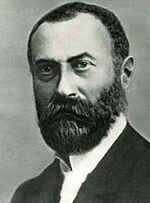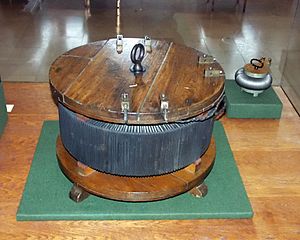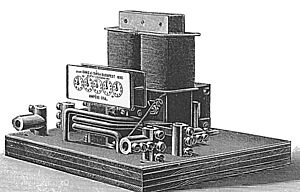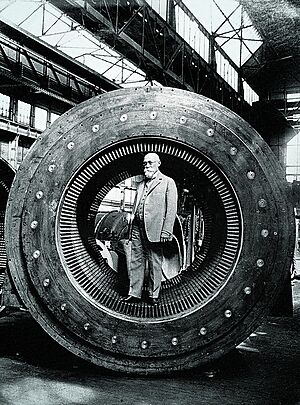Ottó Bláthy facts for kids
Quick facts for kids
Ottó Bláthy
|
|
|---|---|
| Bláthy Ottó | |
 |
|
| Born | 11 August 1860 Tata, Austrian Empire
|
| Died | 26 September 1939 (aged 79) |
| Nationality | Hungarian |
| Known for | Electric transformer, parallel AC connection, and AC electricity meter |
| Scientific career | |
| Fields | Electrical engineering |
Ottó Titusz Bláthy (born August 11, 1860 – died September 26, 1939) was a brilliant Hungarian electrical engineer. He helped invent many important electrical devices. These include the modern electric transformer, which changes electricity voltage. He also helped create the AC watt-hour meter, which measures how much electricity you use.
Bláthy's journey as an inventor started in 1883 at the Ganz Works factory. There, he worked on creating the transformer. He even came up with the name "transformer" itself! In 1885, he teamed up with two other Hungarian engineers, Miksa Déri and Károly Zipernowsky. Together, they invented the ZBD model alternating-current transformer. The name "ZBD" comes from the first letters of their last names. Later, in 1889, he also patented the AC watt-meter.
Contents
Early Life and Learning
Ottó Bláthy went to school in Tata and Vienna. He earned a diploma in machinery in 1882. After finishing school, he worked for the Hungarian Railways from 1881 to 1883.
He was very interested in the work of Károly Zipernowsky. So, on July 1, 1883, he joined Zipernowsky's team. Bláthy admitted he hadn't learned much about electricity in college. Because of this, he decided to teach himself. He used complex math, like Maxwell equations, to figure out how to design magnetic coils. His methods were very advanced for his time.
Amazing Inventions
Bláthy's way of calculating things was key to building the first useful transformer. He used his findings to improve machines in 1883. This made them work better without being heavier. He was also the first to study how electric motors get hot. He found out how the amount of electricity flowing through them relates to heat.
Improving the Transformer
In 1884, Bláthy saw an early transformer system at an exhibition. He knew he could make it much better. He worked with Miksa Déri at the Ganz factory in 1884. They experimented with a "closed-loop magnetic field." This idea came from Faraday's work.
Their experiments led to the invention of the modern transformer in 1885. It was shown to the public at the Budapest National Exhibition. Bláthy, Zipernowsky, and Déri (ZBD) realized that older transformers were not good enough. They couldn't control voltage well.
In their 1885 patents, they described two new transformer designs. These designs used a "closed magnetic circuit." This meant the electricity's magnetic path stayed mostly inside the iron core. These two designs are still used today. The Ganz factory made the first five of these new, efficient transformers in 1884.
Making Electricity Available
The new ZBD transformers were much more efficient. They were over three times better than older designs. The ZBD patents also included two other big ideas. One was using "parallel connections" for homes and businesses. This meant each device got its own power, instead of being connected in a long chain.
The other idea was using transformers with a high "turns ratio." This allowed power plants to send electricity at very high voltages. Then, transformers could lower the voltage for safe use in homes. This made it possible to bring electricity to many places. Bláthy suggested the closed cores. Zipernowsky suggested the parallel connections. Déri did the experiments to make it all work.
In early 1885, they also solved the problem of "eddy current losses." These losses made transformers waste energy as heat. They fixed this by using thin layers of metal in the cores.
The Electricity Meter
In 1889, Ottó Bláthy's patent for the AC kilowatt-hour meter was shown. It was at the Frankfurt Fair. This meter, often called a "Bláthy-meter," was the first of its kind. The Ganz factory started selling them that same year. Even today, the electricity meters we use work on the same basic idea as Bláthy's invention.
Visiting America
In 1886, Bláthy traveled to America. He visited the Edison Works, a famous electrical company. He noticed that they used old-fashioned ways to design parts for their machines. Bláthy showed them how to use exact calculations instead. The engineers at the factory were very impressed!
Connecting Power Plants
Bláthy's work also led to a big step forward in power plants. In 1886, the Italian government ordered a power transformer for Rome. Later, the Ganz factory built a power plant in Tivoli. It used six water turbines to make electricity. This new plant was connected to older steam engine generators. This was the first time in history that two high-voltage power plants were connected together!
Chess Master
Besides his amazing work in science, Ottó Bláthy was also known for his chess problems. He was especially good at creating very long chess puzzles. These puzzles needed many moves to solve.
Images for kids







